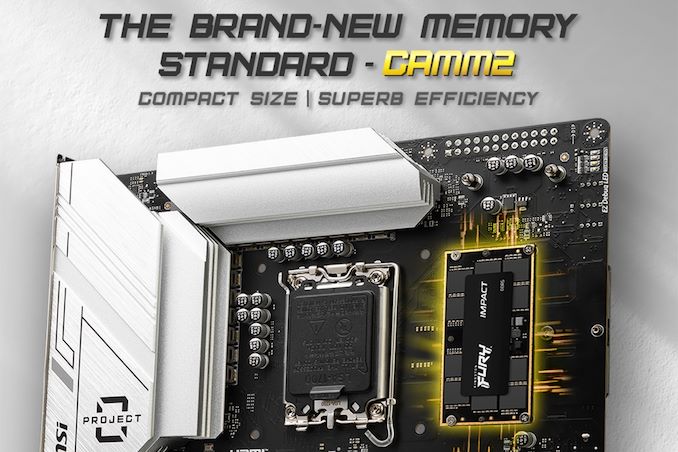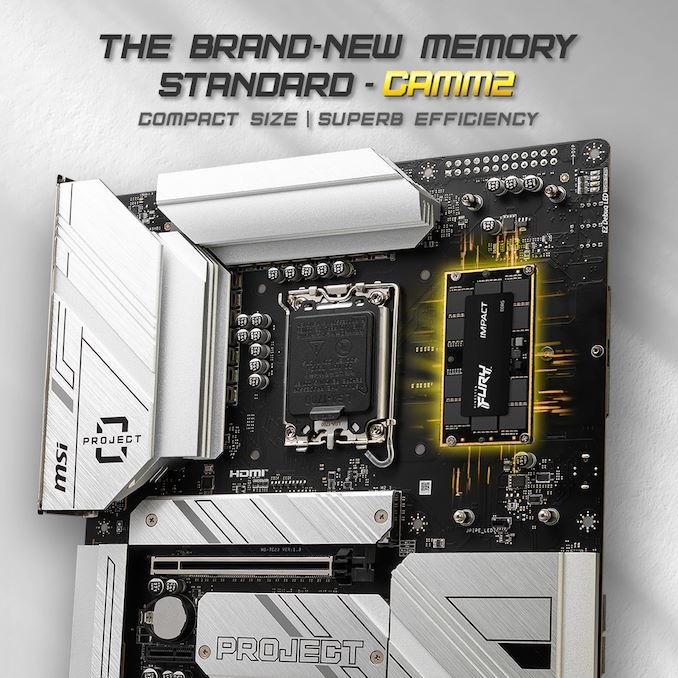Author: AnandTech

MSI on Thursday published the first image of a new desktop motherboard that supports the innovative DDR5 compression attached memory module (CAMM2). DDR5 CAMM2 modules are designed to improve upon the SO-DIMM form factor used for laptops, alleviating some of the high-speed signaling and capacity limitations of SO-DIMMs while also shaving down on the volume of space required. And while we’re eagerly awaiting to see CAMM2 show up in more laptops, its introduction in a PC motherboard comes as a bit of a surprise, since PCs aren’t nearly as space-constrained.
MSI’s Z790 Project Zero Plus motherboard, which supports Intel’s latest 14th Generation Core processors, is to a large degree a proof-of-concept product that is showcasing several new technologies and atypical configuration options. Key among these, of course, is the CAMM2 connector. The single connector supports a 128-bit DDR5 memory bus, allowing for a system to be fully populated with RAM with just a single, horizontally-mounted CAMM2 module. And in terms of design, the Zero Plus also features backside power connectors for improved cable management.

CAMM2 is designed to replace traditional modules in an SO-DIMM form-factor and is meant to occupy up to 64% less space than two DDR5 SO-DIMMs. In addition, CAMM2 greatly optimizes signal and power traces inside the motherboard, primarily by ensuring all memory trace lengths are identical, reducing some of the signaling penalties that normally come from supporting multiple SO-DIMM slots in a system. With DDR5 being particularly sensitive here – to the point where 2 DIMM Per Channel (2DPC) configurations take a max frequency hit even on desktop systems – CAMM2 modules are expected to simplify and, to a degree, improve laptop designs to better match DDR5’s limitations.
Though whether CAMM2 sees widespread adoption remains to be seen. Unlike it’s LPDDR5X counterpart, LPCAMM2, DDR5 CAMM2 hasn’t attracted the same interest from laptop vendors quite yet, in large part because it doesn’t introduce any new functionality (e.g. socketed LPDDR5X).
Meanwhile CAMM2 in ATX desktops is all but unexplored right now, which is why we’re seeing experimental products like MSI’s motherboard. The space savings alone aren’t as important in desktops due to their size – though CAMM2 does cut down on Z-height, keeping memory away from CPU coolers. But PC makers will be looking at other factors such as inventory, as equipping desktop boards with CAMM2 connectors would allow them to use the same memory modules in both laptops and desktops. And longer term there is the question of whether CAMM2 can deliver tangible signaling benefits over traditional DIMMs.
MSI plans to showcase its Z790 Project Zero Plus platform at Computex, alongside memory partner Kingston. The latter will be at the show to demonstrate its Fury Impact CAMM2 memory module, which is one of the first DDR5 CAMM2 modules to be announced.
